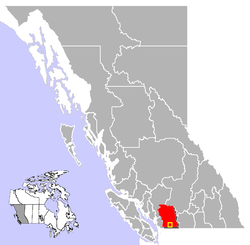Chilliwack is a Canadian city in the Province of British Columbia. It is a predominantly agricultural community with an estimated population of 70,000 people. The city is surrounded by mountains, and has many parks nearby such as Cultus Lake and Chilliwack Lake Provincial Parks. There are many recreational opportunities in the area, including hiking, biking, camping, fishing, and golf. Chilliwack is the seat of the Fraser Valley Regional District.
Location
(according to Statistics Canada 2006 census) Population: 69,217 Growth Rate (2001-2006): 10.6% Total Private Dwellings: 27,929 Area: 260.19 km². Density: 266.0 people per km².
Demographics
Chilliwack's primary industries are agriculture, manufacturing, and tourism. The city is particularly famous for its fishing, golf, hiking and year round whitewater rafting. The Canadian military used to have an army training base in Vedder Crossing, but it was closed in the mid 1990s. Today all that remains is the Army's area support unit or ASU. The remainder of the base has since been converted into the Canada Education Park, which houses the RCMP's Pacific Regional Training Centre (PRTC) and is the site of the new eastern campus of the University College of the Fraser Valley (UCFV)[1]. UCFV's current campus is on Yale Road.
Industry
Between 5,000 and 10,000 years ago the Sto:lo arrived in the Chilliwack area. At the time of their first contact with Europeans it is estimated that there were as many as 30,000 people living within Sto:lo territory.
In 1857, gold was discovered in the Fraser Canyon. By 1858, over 30,000 gold miners had treked to the goldfields, most travelling through the Chilliwack area. By the mid 1860's several farms had grown up around the steamboat landings on the Fraser River called Miller's Landing, Sumas Landing and Chilliwack Landing.
The Township of Chilliwack was incorporated in 1873, the third municipality in British Columbia. Initial settlement was along the Fraser River at Chilliwack Landing. Steamboats were the main mode of transportation, carrying goods and passengers between Chilliwack and New Westminster.
With little room for expansion along the river, the commercial area of the town moved south to the junction of the New Westminster-Yale Wagon Road, Wellington Avenue and Young Road, called "Five Corners." A large subdivision called Centreville was built In 1881. The name Centreville was replaced In 1887 by the more popular "Chilliwhack." The area was incorporated in 1908 as a separate municipality, the City of Chilliwack. The City and the Township co-existed for 72 years. In 1980 they merged to form the District of Chilliwack. The District of Chilliwack became the City of Chilliwack in the early 1990s.
The spelling of Chilliwack is sometimes a matter of confusion. Prior to the amalgamation of the City of Chilliwack and the Municipality of Chilliwhack, there were two different spellings. Upon amalgamation, the spelling of the City was used. [2] Archaic spellings include Chilliwhyeuk and other versions closer to the original Halkomelem, the language of the Sto:lo communities around Chilliwack and Sardis.
Sports
The city has a vibrant musical scene to it and has given birth to bands such as The Dixie 9, The Lazy Susans, The 51st Eight, 22 Hookers, Abandon All, A Canadian Werewolf In..., The Airheads, Closer to Chaos, The Dirt, DRB, James Dream & the Dream Machines, Mortality Fading, Natal Cleft, New World On Fire, Nuisance, Pond Scum, Scantily Clad, The Skamps, Taylor Geddes, Mystery Machine, The Darkest of the Hillside Thickets, Eugene's Axe, Whitey andNecros 52.
Music
Surrounded by tall mountain peaks, such as the dramatic Mount Cheam, Slesse Mountain, and the Fraser and Vedder Rivers, Chilliwack's natural setting is magnificent. Unfortunately, some argue that the city itself, once a small agricultural town, has become an example of sprawling suburbia and bad city planning. Efforts to revitalize the languishing downtown, and to curb the spread of housing subdivisions into previously valuable farmland have proved contentious.
Scenery
Chilliwack's mild climate with limited extremes provides excellent growing conditions for a wide variety of crops and agricultural products. The average temperature is 1.6 degrees Celsius in January and 18 degrees Celsius in July. Precipitation falls mostly as rain, with snow limited, for the most part, to the surrounding mountains.
As Chilliwack is situated at the end of the Fraser Valley, it is one of the wettest cities in the valley. Rain clouds funnel to the end of the valley and, as they are pushed over the mountains, drop their cargo. This occurrence is most frequently seen in November and December, when locals claim that it is not uncommon for it to rain during the entire month. Despite the region's reputation for rain, most of it falls in the rather extensive winter months. Summers are usually sunny and pleasant, with long days (light out until well after 10pm in June with dusk that lasts for hours), little rain, comfortable daytime temperatures, refreshing nights, and minimal humidity.
Due to its location at the eastern end of the Fraser Valley, there is some debate about Chilliwack's air quality. It is often said that air pollution from Vancouver and other "up wind" cities accumulates at Chilliwack, particularly during the summer months. However, the complexities of the Lower Mainland airshed with its microclimates and point source pollution (for example aerosols from farms) along with the increasing and ubiquitous presence of automobiles, make such generalizations problematic. There is general agreement that, as with other urban-rural parts of the world, there has been a decline in the air quality of the Fraser Valley. This has been the subject of a recent Spare Our Air campaign and a protest against the construction of a power plant in nearby Sumas, Washington.
 Climate
ClimateMurphy Aircraft at Chilliwack Airport makes kit airplanes for the do-it-yourself. Approximately 6 years ago Stream has built a call-center in Chilliwack that employs 1500+ people and Soprema has built a factory that builds roofing materials. And now they have also built a new industrial park that includes a new Kal-Tire retreading plant.
People from Chilliwack

 Lefthit
Lefthit
No comments:
Post a Comment